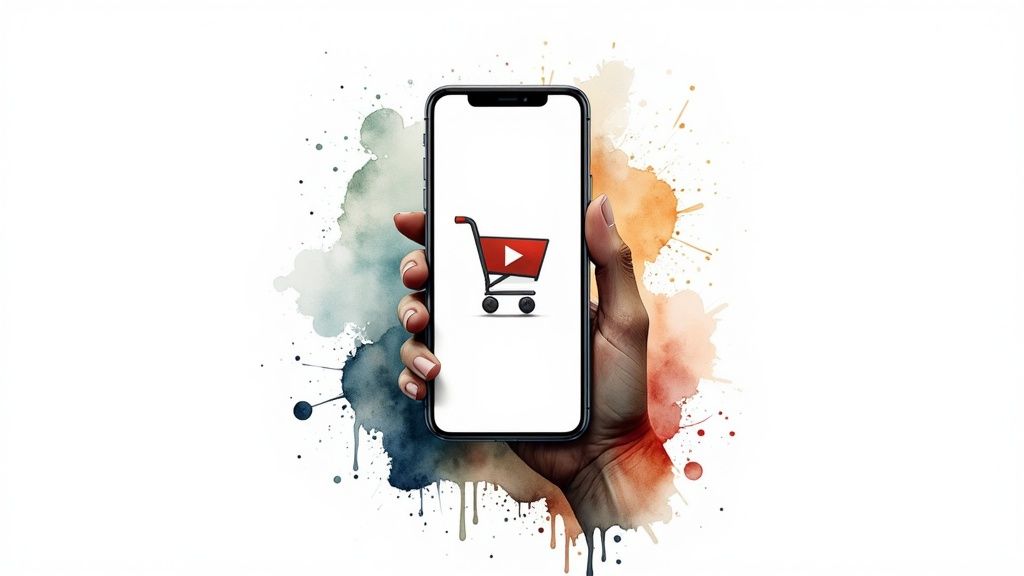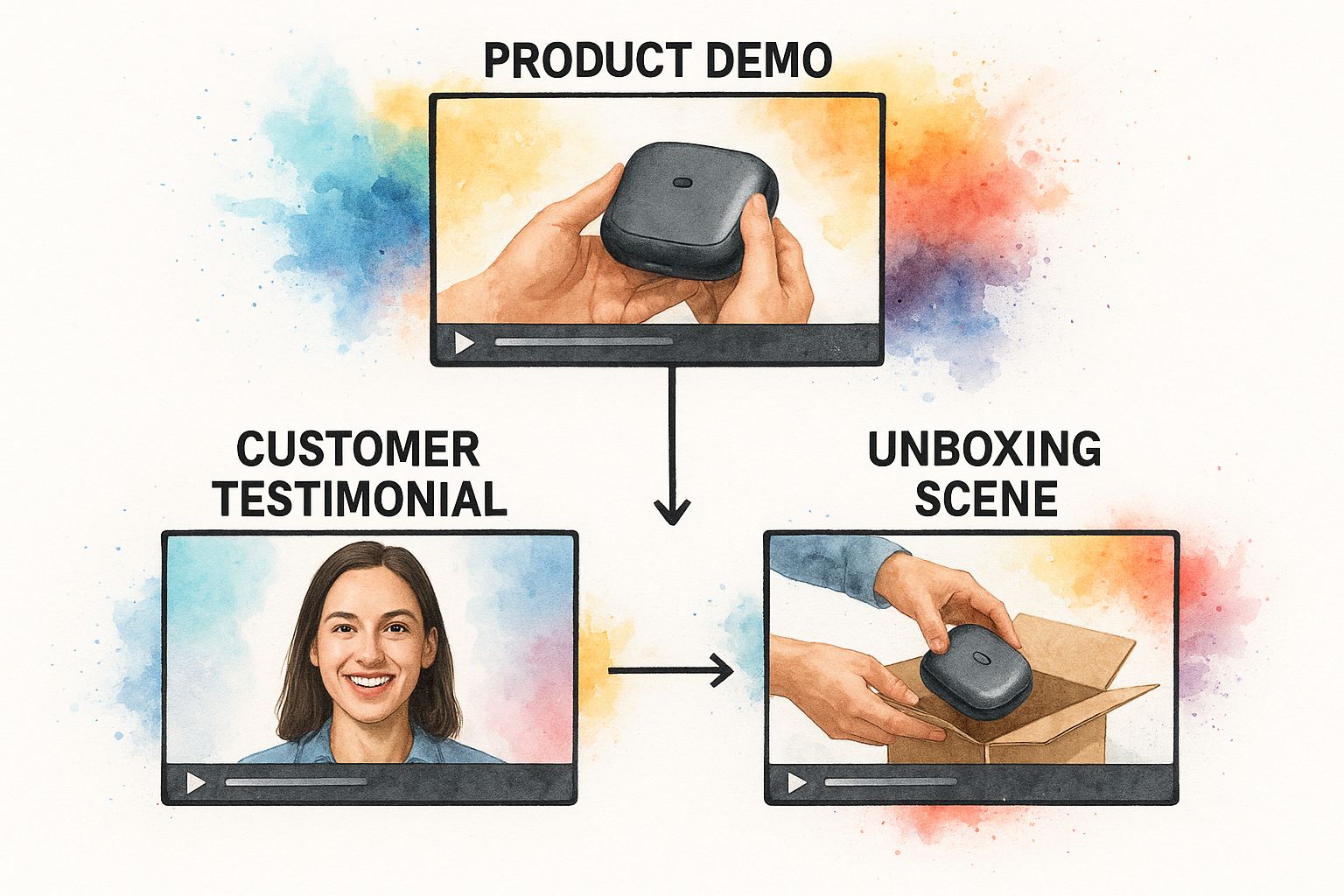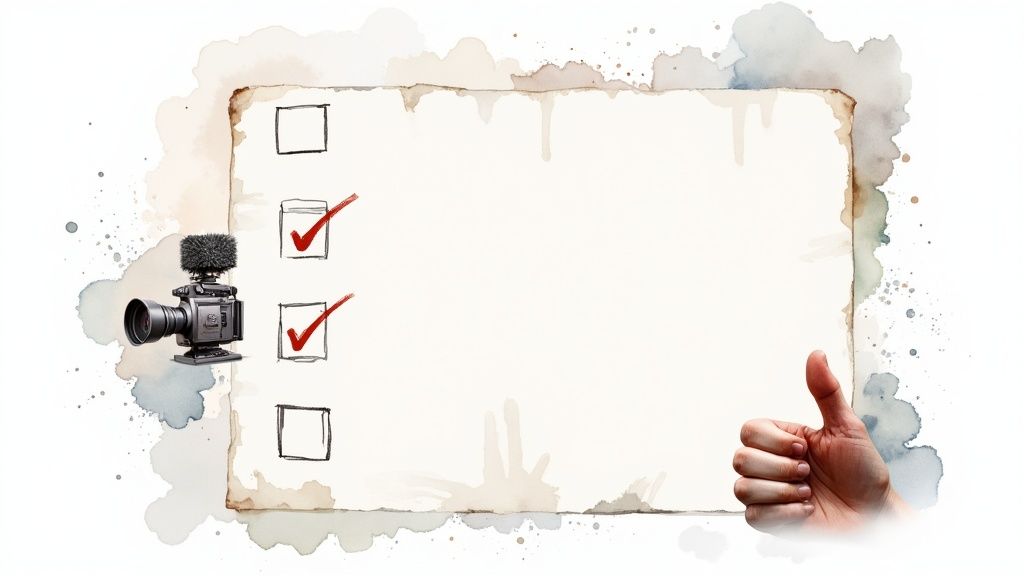Discover how to create powerful e commerce videos that boost engagement and drive sales. Learn video types, production tips, and distribution strategies.
In This Article
Subscribe to our newsletter
Think of e-commerce videos as your secret weapon, a digital sales assistant working around the clock. They're what you use to show off a product and build that crucial layer of trust when a customer can't physically touch or see it. They turn a flat, static product page into a dynamic experience, showing your items in action, answering questions before they're even asked, and giving shoppers the confidence they need to finally click "buy."
Simply put, they are the single best way to bring the in-store experience online.
How Video Transforms the Online Shopping Experience

Put yourself in your customer's shoes. They land on your online store and see a beautiful, high-quality photo of a backpack. But they can't feel the fabric, test the zippers, or get a real sense of how much it can actually hold. That flicker of uncertainty is the biggest hurdle in online shopping.
Static images show what a product looks like. An e-commerce video, on the other hand, shows what it feels like to own and use it.
Video is what closes that critical gap between a casual browse and a confident purchase. It’s your virtual salesperson, showing off products from every conceivable angle, 24/7. It can highlight the texture of a fabric, demonstrate how easily a piece of furniture comes together, or show a gadget in action. This kind of dynamic presentation answers questions customers didn't even know they had, which goes a long way in calming any purchase anxiety.
Building Trust Through Transparency
In a marketplace that's more crowded than ever, trust is your most valuable currency. Videos give your customers a transparent, honest look at your products, which helps manage their expectations and builds a much stronger connection with your brand.
When someone can see exactly how an item works and what it looks like in a real-world context, they feel far more secure in their decision to buy.
This transparency has a direct, positive impact on the health of your business by:
- Slashing Return Rates: A customer who truly understands a product's size, features, and function before they buy is far less likely to send it back.
- Boosting Customer Satisfaction: Clear, helpful video content creates happier customers who feel like they made a smart, informed choice.
- Making Your Brand Unforgettable: An engaging video leaves a lasting impression, setting you apart from competitors who are still just relying on static images and blocks of text.
E-commerce videos aren't a "nice-to-have" anymore; they are a fundamental part of the modern customer's journey. They communicate value in a way text and images can't, making your products feel tangible and desirable in a digital world.
At the end of the day, video is the most powerful tool you have for recreating the confidence of a physical retail experience online. It turns hesitant viewers into informed buyers, paving the way for higher conversions and lasting brand loyalty.
Why You Should Be Investing in Video Content
Alright, let's move past the "what" and get straight to the "why." We're talking hard numbers and real strategic advantages that make e-commerce videos an essential investment, not just a line item in your creative budget. Putting money into video production isn't a shot in the dark; it's a data-backed decision that directly beefs up your bottom line.
Think of it this way: video isn't some isolated tactic you try once. It's a core part of a robust e-commerce growth strategy, acting as a powerful engine for conversions, engagement, and even your search rankings. The dividends are real and measurable.
Drive More Conversions by Easing Customer Anxiety
At its heart, video works because it solves a fundamental problem with online shopping: uncertainty. When a potential customer can see a product in motion, it answers questions they didn't even know they had. How does that fabric really move? How big is that gadget in someone's hand? What does it sound like when it's running?
Static images just can't compete. This added clarity does wonders for reducing purchase anxiety. The more confident a shopper feels about what they're buying, the faster they'll hit that "Add to Cart" button. It's a simple formula: video builds confidence, and confidence drives conversions.
By showing off a product's value in a dynamic, easy-to-digest format, you're smoothing out the entire buying journey. This doesn't just lead to more sales; it creates a base of happier, more informed customers.
The data backs this up in a big way. Marketers who use video see their revenue grow 49% faster than those who don't. And get this: websites with video content enjoy an average conversion rate of 4.8%, a massive leap from the 2.9% rate for sites that stick to just images.
Boost Your Presence on Search Engines
Beyond the immediate sale, e-commerce videos give you a serious SEO advantage. Search engines like Google are obsessed with user experience, and a key metric they watch is dwell time—the amount of time visitors spend on your page.
Engaging videos are a natural way to keep people on your site longer. Someone who watches a one-minute product demo spends at least 60 more seconds on your page than someone who just skims through photos. That extra time sends a huge signal to Google that your content is valuable, which can push you higher up in the search results.
This creates a fantastic feedback loop:
- Higher Rankings: Better visibility in search results brings in more organic traffic.
- More Traffic: More visitors land on your page and get a chance to watch your videos.
- Increased Engagement: Longer dwell times tell Google your site is the real deal, boosting your rankings even further.
Increase Average Order Value and Build Brand Trust
Video is also your secret weapon for encouraging customers to spend more. When you can clearly demonstrate all the features and benefits, you can make a much stronger case for premium items or handy add-ons. A video can show exactly why the more expensive model is a better investment or how a specific accessory makes the main product even better.
This kind of visual upselling and cross-selling feels less like a hard sales pitch and more like helpful advice. That builds trust. When you consistently provide valuable, informative video content, you establish your brand as an expert in the space. That trust is priceless—it turns one-time shoppers into loyal, repeat customers.
If you're looking for more ways to weave video into your sales strategy, be sure to check out our guide on ecommerce video marketing secrets that drive real sales.
Choosing the Right Type of E-commerce Video
Picking the right type of e-commerce video is a bit like choosing the right tool for a job. You wouldn’t use a hammer to saw wood, right? In the same way, a beautiful brand story video won't close the deal if what your customer really needs is a close-up look at your product's features.
Not all videos are created equal. Each format has a specific job to do along the customer's path to purchase.
The trick is to match your video to a specific business goal. Are you trying to build trust with a skeptical new visitor? Or do you need to show off a complex feature to someone who’s on the fence? Answering that question first will point you directly to the most effective format, making sure your time and effort actually pay off.
This breakdown shows some of the most powerful video types and where they fit into a winning strategy.

As you can see, every format—from detailed demos to genuine testimonials—plays a unique role in moving customers from just browsing to confidently clicking "buy."
Here's a quick reference table to help you match the perfect video format to your specific goals.
Matching Video Formats to Your Business Goals
| Video Type | Primary Goal | Best For | Example Use Case |
|---|---|---|---|
| Product Demos | Showcase Functionality | Tech, gadgets, tools, kitchen appliances | A video showing exactly how a new coffee machine brews an espresso. |
| Close-Up & 360° | Highlight Quality | Jewelry, fashion, high-end furniture | A 360-degree view of a leather handbag, focusing on the stitching and hardware. |
| Testimonials | Build Social Proof | High-value items, health & wellness | A loyal customer sharing how a skincare product cleared up their acne. |
| Unboxing Videos | Manage Expectations | Subscription boxes, electronics, luxury goods | A creator opening your product for the first time, showing the packaging and contents. |
| Behind-the-Scenes | Foster Connection | Artisanal goods, mission-driven brands | A tour of the workshop where your handcrafted ceramics are made. |
| How-To Guides | Educate & Add Value | Complex products, hobby-related items | A tutorial on how to use a specific software or assemble a piece of furniture. |
This table is a great starting point, but let's dive deeper into how these video types work in the real world.
Videos for Highlighting Product Details
When a customer can't touch or feel a product, your videos have to do the heavy lifting. The goal here is to answer all their unspoken questions about quality, feel, and function, giving them the confidence they need to make a purchase.
- Product Demo Videos: These are the absolute workhorses of e-commerce. They show your product in action, plain and simple. Think of a video demonstrating how easily a blender crushes ice or how much you can really fit into an expandable suitcase. They cut right to the chase: does this thing actually work?
- Close-Up and 360-Degree Videos: These are all about the craftsmanship. By showing off the fine details—the texture of the fabric, the quality of the stitching, the intricate parts of a watch—you communicate a level of quality that static photos just can’t touch.
This kind of visual proof is critical. It helps set accurate expectations, which leads directly to happier customers and, just as importantly, fewer returns.
Videos for Building Trust and Authenticity
Trust is the currency of the internet. Without it, you won’t make a sale. Videos that feature real people and genuine experiences are incredibly effective for building that social proof and making your brand feel less like a faceless company and more like a group of people you can count on.
Customer testimonials are the digital equivalent of a friend's recommendation. Hearing a real person share their positive experience with your product is often the final push a hesitant buyer needs to feel confident in their purchase.
These videos forge an emotional connection that a dry product description could never achieve.
- Customer Testimonial Videos: Feature happy customers sharing their honest thoughts. The best ones feel completely unscripted and genuine, capturing real enthusiasm.
- Unboxing Videos: This format taps directly into the excitement of getting something new. It shows the entire experience, from opening the box to the first impression, which helps build anticipation while managing expectations about packaging and presentation.
- Behind-the-Scenes Videos: Give your audience a peek behind the curtain. Show them how your products are made or introduce them to the people on your team. This kind of transparency creates a powerful connection and makes your brand memorable.
Videos for Educating and Engaging Your Audience
Great e-commerce videos do more than just sell; they add real value. By creating educational content, you can position your brand as a helpful expert in your field, building long-term relationships that keep customers coming back.
How-to videos and tutorials are perfect for this. They solve a real problem for your audience or teach them how to get more out of the products they buy from you. For instance, a skincare brand could create a video on "The Perfect Morning Skincare Routine," using its products to provide helpful, non-pushy advice.
This strategy is a triple win:
- It positions your brand as an authority. You become the go-to source for information in your niche.
- It boosts product satisfaction. When customers know how to use your products correctly, they get better results and are happier with their purchase.
- It drives organic traffic. These videos often rank well on Google and YouTube for "how-to" searches, bringing fresh eyes to your brand.
Ultimately, picking the right video is all about empathy. Put yourself in your customer's shoes, understand what they need at each step, and create content that genuinely helps them.
A Practical Guide to Producing High-Impact Videos
You don't need a Hollywood budget or a massive film crew to create e-commerce videos that actually get results. The secret isn't spending more money; it's about being smarter with your process.
By breaking it down into three simple stages—Pre-Production, Production, and Post-Production—any brand can create professional-looking videos that connect with customers and drive sales.
Honestly, a well-planned video shot on a smartphone will always outperform a disorganized but expensive one. It all comes down to planning and efficiency.
Stage 1: Pre-Production — Planning Your Success
This is where the magic really happens. Pre-production is the foundation of your entire project, and getting it right saves you a ton of time, money, and headaches down the road. Think of it as creating the blueprint before you start building.
First things first: the script. It doesn't need to be a literary masterpiece. It just needs to map out your key message, the product benefits you want to highlight, and a clear call-to-action. What do you want someone to do after watching?
Next, sketch out a quick storyboard. We're not talking fine art here—stick figures are totally fine. A storyboard helps you visualize each shot, making sure the final video tells a cohesive and compelling story from start to finish. This planning stage is your best friend for catching problems before you ever hit the record button.
Stage 2: Production — Capturing Quality Content
With your plan in hand, it’s time to shoot. And while a fancy camera is nice, modern smartphones are more than capable of capturing stunning 4K video. Instead, your focus should be on two things that scream "professional": lighting and sound.
Clear, crisp audio is non-negotiable. People will forgive slightly grainy video, but they will click away in a heartbeat if the sound is muffled or hard to hear. An inexpensive lavalier microphone can make a world of difference.
As for lighting, just follow a few simple rules:
- Use Plenty of Light: Natural light from a window is your best bet. If that’s not an option, a simple ring light or a basic three-point lighting setup can wipe out shadows and make your products look amazing.
- Keep it Steady: A shaky camera just looks amateur. A simple tripod for your phone or camera will give you those smooth, stable shots you're looking for.
- Mix It Up: Keep things visually interesting by capturing a mix of wide shots, medium shots, and close-ups. This helps highlight all the important details of your product.
It's a common myth that production is the most important part. The truth is, a solid pre-production plan makes the actual shoot feel easy, efficient, and way more likely to give you the high-quality footage you need.
If you'd rather leave it to the pros, there are fantastic content creation services that can help bring your vision to life.
Stage 3: Post-Production — Polishing Your Video
Once you have your footage, it's time to assemble it into a polished final product. Post-production is where you edit your clips, add music, drop in graphics, and truly shape your story. Thanks to user-friendly software and new AI tools, this step is more accessible than ever.
The use of AI in video production has absolutely exploded, jumping from 18% to 41% in just one year as more brands use it to create amazing content, fast. For e-commerce, product demo videos are a powerhouse, compelling around 87% of viewers to make a purchase after watching.
Here’s a quick checklist for post-production:
- Assemble the Edit: Arrange your best takes into a logical sequence that tells a clear and engaging story.
- Add Music & Sound: Pick royalty-free music that fits your brand’s vibe and enhances the video's mood.
- Incorporate Graphics: Use text overlays to call out key benefits or add your logo to reinforce your brand.
- End with a Strong CTA: Tell your viewers exactly what to do next, whether it’s "Shop Now," "Learn More," or "Subscribe."
Tools like Aeon can make this whole process incredibly simple, helping you turn your ideas into engaging videos with minimal fuss.
To see just how much video can transform your business, check out our guide to boost sales with video for ecommerce. By following these three stages, you can consistently produce high-quality e commerce videos that not only look fantastic but also deliver real, measurable results.
Optimizing and Distributing Videos for Maximum Reach

So you've created a fantastic product video. That's a great first step, but it's only half the battle. What you do after you hit export is what truly determines your success. A brilliant video no one sees is just a missed opportunity.
Think of it this way: distribution and optimization are what get your video in front of the right eyeballs, on the right platform, at the exact moment they're ready to buy. Without a solid plan, even the most compelling e-commerce videos will just get lost in the noise.
Mastering Video SEO Fundamentals
First things first, you need to make your video discoverable. Video SEO is all about signaling to search engines like Google and YouTube what your video is about so they can show it to people who are actively looking for it.
Start with a strong title and description. Pack them with keywords your customers would actually type into a search bar. Instead of a generic "New Backpack Video," try something specific like "The Ultimate Waterproof Commuter Backpack | Product Demo." It immediately tells both humans and algorithms what to expect.
Don't stop there. Thumbnails and captions are your secret weapons.
- Create Click-Worthy Thumbnails: Your thumbnail is your video's first impression. Make it count. Use a high-quality, eye-catching image with bold text or a friendly face to make people stop scrolling and click.
- Add Captions and Transcripts: This is a no-brainer. Captions make your videos accessible and watchable with the sound off. But more importantly, search engines can read that text, giving them crucial context to index and rank your video correctly.
Your thumbnail is the billboard for your video. A well-designed thumbnail can dramatically increase your click-through rate, turning passive scrollers into engaged viewers.
Nailing these SEO basics gives your video the best possible chance of being found organically. It's the foundation you need before you start pushing it out everywhere.
A Multi-Channel Distribution Strategy
With your video fully optimized, it's time to unleash it. A multi-channel strategy is about meeting your customers where they already are, which maximizes your reach and impact.
Your own product pages are the most critical destination. Embedding a high-quality demo or explainer video right where someone is about to make a purchase decision can be incredibly powerful. It answers questions and shows the product in action, often pushing conversion rates way up.
Next up is social media. This is where things get really interesting. Video content is absolutely exploding, and it's projected to account for a staggering 82% of all internet traffic. The rise of short-form video has completely changed the game, especially for younger shoppers.
You'll need to tailor your video for each platform to get the best results:
- TikTok and Instagram Reels: Think short, energetic, vertical videos. You have about three seconds to grab someone's attention. Use trending sounds and quick cuts to fit the native style.
- Facebook and YouTube: These platforms are perfect for longer content. This is where you can post detailed tutorials, powerful customer testimonials, or behind-the-scenes stories that build a real connection with your audience.
Finally, don't forget about email. Dropping a video thumbnail into your email campaigns is a proven way to boost click-through rates. Announce new products, share customer stories, or offer exclusive video tutorials to your subscribers to pull them back to your site.
For a deeper dive into crafting ad content for these channels, you can learn how to create video ads that convert in our complete guide.
Answering Your Top E-Commerce Video Questions
Jumping into e-commerce videos can feel like a big step, but you're not alone. Most business owners run into the same questions and roadblocks when they're just starting out. Let's clear up those common points of confusion right now.
Think of this as the last little push you need. Once these questions are answered, you'll be ready to build a video strategy that actually moves the needle for your business.
What’s the Ideal Length for an E-Commerce Video?
This is easily the most common question we hear, and the honest answer is... it depends. There’s no magic number that works everywhere. The real key is to match the video's length to the platform and your specific goal, delivering as much value as you can in the shortest time possible.
- On Product Pages: Keep it between 30 and 90 seconds. This is your sweet spot to show off the best features and see the product in action without losing someone's interest right when they're about to buy.
- For Social Media: Think short and punchy. On platforms like Instagram Reels or TikTok, you have just a second to grab attention. Aim for 15 to 60 seconds.
- On YouTube: Here, you've got more room to work with. People come to YouTube for deeper content, so longer videos like detailed tutorials or how-to guides often perform much better.
Don't think about video length in seconds; think about it in value. The moment the value stops, the video should end. Check your analytics to see where people drop off—that data is gold for figuring out the perfect length for your next e-commerce videos.
When you tailor the length to what a viewer expects on each platform, you make sure your message actually gets through.
Do I Need Expensive Gear to Create Product Videos?
Not at all. This is probably the biggest myth holding businesses back from making video. The truth is, the smartphone you already own is more than capable of shooting the high-quality video you need to get great results.
Before you even think about a fancy camera, put your money into two things that make a much bigger difference: good lighting and clear audio.
People might forgive a slightly fuzzy video, but bad audio is a deal-breaker. If a viewer can't hear you clearly, they're gone. A simple, affordable lavalier mic that clips to your shirt can make your sound quality ten times better. Likewise, a basic ring light or a couple of softbox lights will get rid of ugly shadows and make your products look fantastic.
Start by creating helpful, clear content first. You can always upgrade your camera gear later on, once you see the sales rolling in.
How Can I Measure the ROI of My Videos?
Tracking the return on investment (ROI) from your videos isn't just a "nice-to-have"—it's a must. You have to know what's working so you can do more of it. The trick is to connect your video metrics directly to business goals, like sales and leads.
Start by looking at a few specific numbers, depending on where your video lives:
- On Your Website: A great test is to compare the conversion rate on product pages with video to those without. Also, keep an eye on the "time on page"—if people are sticking around longer, your video is doing its job.
- On Social Media: The big one here is the click-through rate (CTR) from your video post over to your store. Watch time and the number of shares are also great signs of content that's hitting the mark.
- In Email Marketing: This one's simple. What's the CTR on emails that include a video thumbnail versus those that don't?
If you want a direct line from a video to a sale, try this: create a unique discount code that you only share in one specific video. When you see that code used at checkout, you know for a fact that revenue came directly from your video. It’s a simple way to prove that video isn't just a creative cost—it's a powerful sales tool.
Creating high-impact e-commerce videos is simpler than ever with the right tools. Aeon empowers you to transform your content into stunning, professional videos at scale, helping you engage customers and drive sales with ease. See how it works at https://www.project-aeon.com.


.jpg)